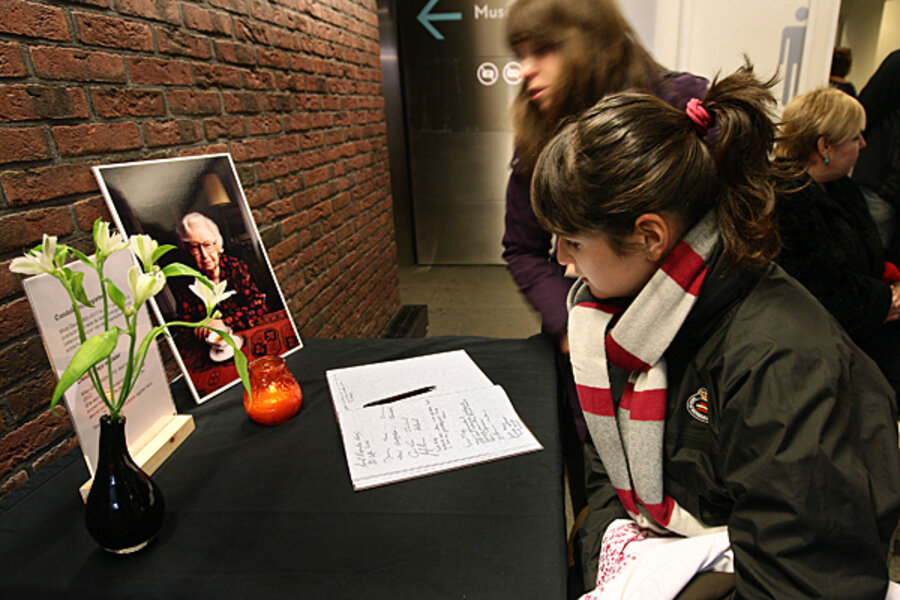Miep Gies, Anne Frank's protector, champion of tolerance.
Loading...
| Amsterdam, Netherlands
Miep Gies, the office secretary who defied the Nazi occupiers to hide Anne Frank and her family for two years and saved the teenager’s diary, has died, the Anne Frank House museum said Tuesday. She was 100.
Gies was the last of the few non-Jews who supplied food, books and good cheer to the secret annex behind the canal warehouse where Anne, her parents, sister and four other Jews hid for 25 months during World War II.
After the apartment was raided by the German police, Gies gathered up Anne’s scattered notebooks and papers and locked them in a drawer for her return after the war. The diary, which Frank had been given on her 13th birthday, chronicles her life in hiding from June 12, 1942 until August 1, 1944.
Gies refused to read the papers, saying even a teenager’s privacy was sacred. Later, she said if she had read them she would have had to burn them because they incriminated the “helpers.”
Frank died at age 15 in the Bergen-Belsen concentration camp in March 1945, just two weeks before the camp was liberated. Gies gave the diary to Frank’s father Otto, the only survivor, who published it in 1947.
“Every day for over two years she put herself in danger by hiding Jews from the Nazis,” said Anne Frank’s cousin, Bernd “Buddy” Elias, who last saw Gies on her 100th birthday. “If they had caught her, she would have been put in a concentration camp herself.”
Her death removed one of the last living direct links to Anne Frank, with only Elias and a few of her childhood friends still alive.
An online registry quickly recorded hundreds of condolences from around the world.
After the diary was published, Gies tirelessly promoted causes of tolerance. She brushed aside the accolades for helping hide the Frank family as more than she deserved — as if, she said, she had tried to save all the Jews of occupied Holland.
“This is very unfair. So many others have done the same or even far more dangerous work,” she wrote in an e-mail to The Associated Press days before her 100th birthday in February 2009.
“The Diary of Anne Frank” was the first popular book about the Holocaust, and has been read by millions of children and adults around the world in 70 languages.
For her courage, Gies was bestowed with the “Righteous Gentile” title by the Israeli Holocaust museum Yad Vashem. She has also been honored by the German Government, Dutch monarchy and educational institutions.
Nevertheless, Gies resisted being made a character study of heroism for the young.
“I don’t want to be considered a hero,” she said in a 1997 online chat with schoolchildren.
“Imagine young people would grow up with the feeling that you have to be a hero to do your human duty. I am afraid nobody would ever help other people, because who is a hero? I was not. I was just an ordinary housewife and secretary.”
Born Hermine Santrouschitz on Feb. 15, 1909 in Vienna, Gies moved to Amsterdam when she was 11 to escape food shortages in Austria. She lived with a host family who gave her the nickname Miep.
In 1933, Gies took a job as an office assistant in the spice business of Otto Frank. After refusing to join a Nazi organization in 1941, she avoided deportation to Austria by marrying her Dutch boyfriend, Jan Gies.
As the Nazis ramped up their arrests and deportations of Dutch Jews, Otto Frank asked Gies in July 1942 to help hide his family in the annex above the company’s canal-side warehouse on Prinsengracht 263 and to bring them food and supplies.
“I answered, ’Yes, of course.’ It seemed perfectly natural to me. I could help these people. They were powerless, they didn’t know where to turn,” she said years later.
Jan and Miep Gies worked with four other employees in the firm to sustain the Franks and four other Jews sharing the annex. Jan secured extra food ration cards from the underground resistance. Miep cycled around the city, alternating grocers to ward off suspicions from this highly dangerous activity.





